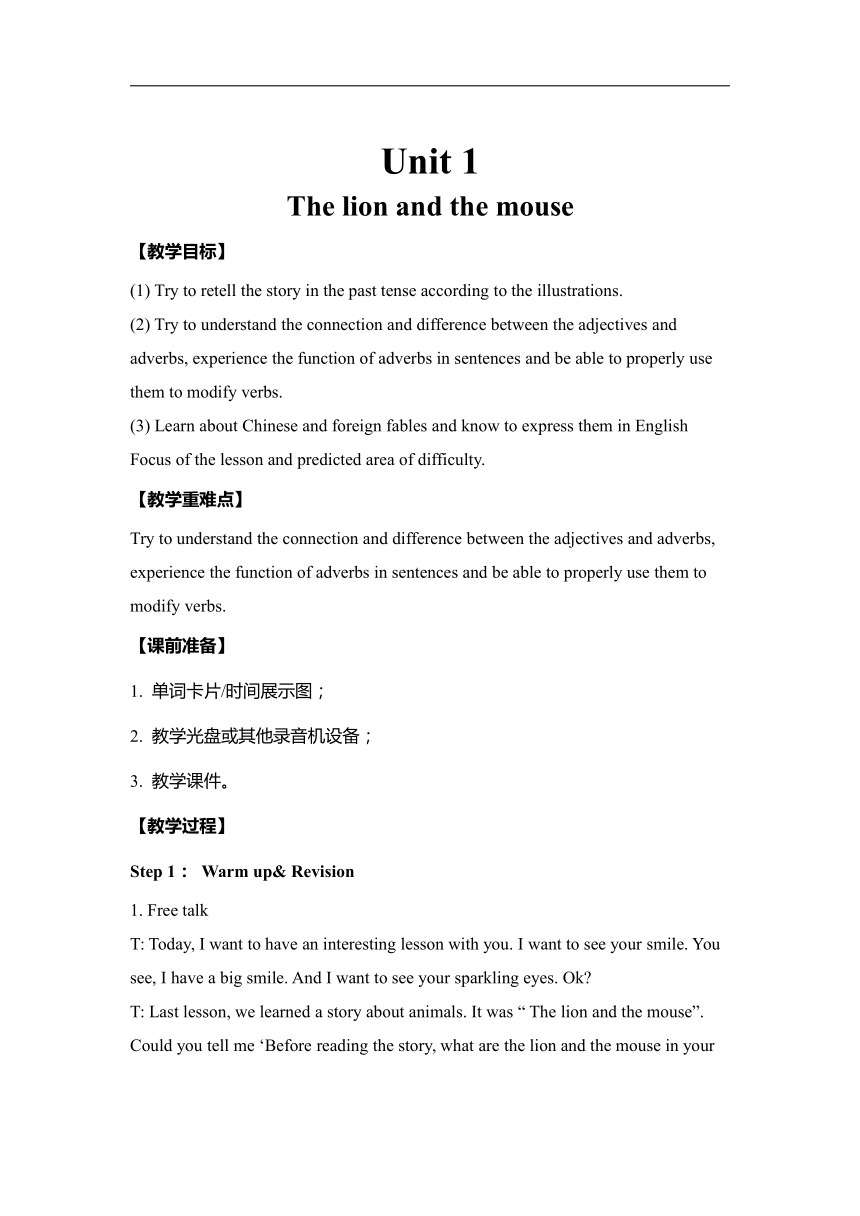Unit 1 The lion and the mouse 教案
文档属性
| 名称 | Unit 1 The lion and the mouse 教案 |  | |
| 格式 | zip | ||
| 文件大小 | 17.0KB | ||
| 资源类型 | 教案 | ||
| 版本资源 | 牛津译林版 | ||
| 科目 | 英语 | ||
| 更新时间 | 2019-04-24 10:11:42 | ||
图片预览


文档简介
Unit 1
The lion and the mouse
【教学目标】
(1) Try to retell the story in the past tense according to the illustrations.
(2) Try to understand the connection and difference between the adjectives and adverbs, experience the fun_ction of adverbs in sentences and be able to properly use them to modify verbs.
(3) Learn about Chinese and foreign fables and know to express them in English Focus of the lesson and predicted area of difficulty.
【教学重难点】
Try to understand the connection and difference between the adjectives and adverbs, experience the fun_ction of adverbs in sentences and be able to properly use them to modify verbs.
【课前准备】
1. 单词卡片/时间展示图;
2. 教学光盘或其他录音机设备;
3. 教学课件。
【教学过程】
Step 1: Warm up& Revision ?
1. Free talk
T: Today, I want to have an interesting lesson with you. I want to see your smile. You see, I have a big smile. And I want to see your sparkling eyes. Ok?
T: Last lesson, we learned a story about animals. It was “ The lion and the mouse”. Could you tell me ‘Before reading the story, what are the lion and the mouse in your mind?’? For example, I think the lion is the king of the forest and the mouse is always afraid of the cat. What about you?
T: After learning the story, do you still think the mouse is always weak? Why?
2. Revision
a. Retell the story ( work in groups)
T: Do you still remember the whole story? Let’s try to retell it according to the illustrations. Here’s one tip for you. (We often use the past tense to retell the story.) T: Are you ready? This time, let’s try to retell the story in class. Each of us just say one or two sentences and let others continue. ?
Step 2: Presentation ?
1. Grammar time
a. Read and feel ( encourage students to recall the dialogue between the lion and the mouse in the text and appreciate the feelings behind their dialogue)
E.g:
T: Look at the little mouse, is he dancing? No, he is shaking. How did he feel at that time?
T: What about this lion? Yes, he was laughing. What made him so happy? Who’d like to be the lion and read this sentence?
T: Look at this lion, was he happy? Where was he? So what did he think? How did he say?
T: Finally, the mouse helped him. And they became friends. So the lion said happily. Let’s try together.
b. Think and discuss ( present the first part in Grammar time and encourage students to find out the structure of these sentences)
T: Can you tell me the structure of these sentences?
T: What are the adverbs for? ( present two sentences to contrast and help them better understand the role of the adverb)
T: Which one is better?
T: Great! Here are two choices, A is that they can make things clearly and orderly. B is that they can show the actions more vividly.
T: Congratulations! You are right. So we often use adverbs to modify verbs. Could you find that where do we often put adverbs?
c. Look, match and think
T: Just now, we talked about adverbs. Now let’s play a game and try to find their friends.
E.g: excited--excitedly
T: Can you find some rules?
d. Look, guess and say ( present some pictures and conceal some parts of the picture, then encourage students to guess )
2. Culture time a. Think and choose (present three choices: A. Aesop’s Fables B. Fairy Tales C. Chinese Idiom books)
T: We’ve talked about the story. But do you know where is the story from?
b. Know more in details ( encourage students to talk about some stories in these two books)
T: Do you find something in common?
T: What about their difference? I have some stories here, please judge whether it’s Aesop’s Fables or Chinese Idioms? Are you ready?
Step 3:Production ?
1. Make a reading card
a. Introduce how to make a reading card
T: Today we’ve talked about many stories. Do you like stories? Do you often read stories? What do you often do after reading a story?
T: Do you know what do I usually do after reading a story?
T: I’d like to make a reading card. ( prensent one reading card about the lion and the mouse.)
T:Do you want to make one by yourself?
T: First, you can choose one story you like. Then take out the card you’ve prepared before class. Next write down something about the story, for example, the main characters, your favourite characters and so on.
2. Make a reading card by yourself
3. Share in class
4. Stick reading card to the blackboard
T: Wow, you did a good job! It’s really a wonderful reading wall. As we all know, reading is fun. Reading makes us wise. I hope you will like reading and keep this good habits to enrich your life.
Step 4:Homework
a. Read and copy the adverbs we learned in class.
b. Surf the Internet and learn more about adverbs.
c. Read more animal stories after class.
【板书设计】
Unit 1
The lion and the mouse
happily sadly loudly quietly sadly
【教学反思】
教师在单词或词组的教学中,不能只是教读单词或词组。要循序渐进的插入本单元的重点句子,让学生在记单词或词组的过程中熟悉句子。这样能满足不同学习水平的学生的学习要求。根据学生的个人素质、性格特点、记忆力、反应速度等,因材施教,分层要求,以求通过最有效的激励机制促进学生进步。最后,在今后的每一节课中都要灵活运用所学句型,请学生造句,培养学生的创新意识。
